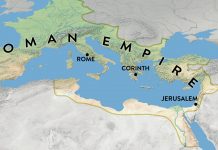“A man was going down from Jerusalem to Jericho, when he was attacked by robbers. They stripped him of his clothes, beat him and went away, leaving him half dead. A priest happened to be going down the same road, and when he saw the man, he passed by on the other side. So too, a Levite, when he came to the place and saw him, passed by on the other side. But a Samaritan, as he travelled, came where the man was; and when he saw him, he took pity on him. He went to him and bandaged his wounds, pouring on oil and wine. Then he put the man on his own donkey, brought him to an inn and took care of him. The next day he took out two denarii and gave them to the innkeeper. ‘Look after him,’ he said, ‘and when I return, I will reimburse you for any extra expense you may have’” (Luke 10:30-35).
In 1996, when the Ku Klux Klan organisation initiated a demonstration in their hometown, Ann Arbor in Michigan (USA), the young black Keshia Thomas was only an 18-year-old teenager. That didn’t stop her from going out to protest against the KKK demonstration along with several hundred other people.
In that atmosphere, so tense that the police deployed agents to protect the KKK group, the presence of a person who had an SS tattoo and wore a T-shirt with the Confederate flag (or St. Andrew’s cross—emblem of the Southern heritage, slavery, and segregation) attracted the attention of anti-KKK demonstrators. The crowd’s fury was unleashed when a woman yelled into a megaphone: “There’s a Klansman in the crowd!” The person started running, but the group of protesters caught up with him. Among them was Keshia who was running “just to chase him down.” When she saw the man knocked down by punches and placards, she threw herself over him, stopping the demonstrators from further hitting him. “When they dropped him to the ground, it felt like two angels had lifted my body up and laid me down,” Keisha told the BBC a few years later.
Mark Brunner, a photographer who was a student at the time, captured the entire scene. “She put herself at physical risk to protect someone who, in my opinion, would not have done the same for her,” Brunner said. “Who does that in our world?”
The young woman did not receive any sign from the man she saved, but she says that she met a member of his family. She was in a cafe, she recalled, when a young man approached her and just said “thank you.” When she asked him why, he replied that the man she had saved was his father. Keshia understood then that the consequences of her gesture could be even greater than what they initially seemed. “For the most part, people who hurt… they come from hurt. It’s a cycle. Let’s say they had killed him or hurt him really badly. How does the son feel? Does he carry on the violence?”
The ticket to eternal life
When a teacher of the law came to Jesus with the question: “What must I do to inherit eternal life?”[1] Jesus answered him with another question: “What is written in the Law? […] How do you read in it?”[2] The answer of the teacher of the law is a surprising one for someone accustomed to a multitude of rules and regulations of the Jewish law. “‘Love the Lord your God with all your heart and with all your soul and with all your strength and with all your mind’; and, ‘Love your neighbour as yourself.'”[3] Jesus answered him: “You have answered correctly. […] Do this and you will live.”[4]
It seems that the teacher of the law was anticipating an answer of this sort. However, he was more interested in the reply to the question that was to follow:
And who is my neighbour?
The question “Who is my neighbour?” was appropriate because the Pharisees had excluded from this category those who did not belong to their caste and those who were not strict or careful with the laws regarding purification. The Essenes (Dead Sea sectarians) considered themselves children of the light, and all others were children of darkness, deserving to be hated. In the end, the Jews excluded everyone, especially the Samaritans. Jesus was not asked for a definition of the term “neighbour,”[5] but for an indication on how to draw the limits of the duty to love within the community. How far does my responsibility extend? That was the true meaning of the question.[6]
It is hard to imagine the surprise and shock of the teacher of the law when he learns that the hero in the parable told by Jesus was a wretched Samaritan. Why did Jesus choose a Samaritan to be the one who risked his life to tend to the wounds of the Jewish traveller?
Just how neighbouring is my “neighbour”?
The impact of this event can be erroneously diminished by an understimation of the hostility between Jews and Samaritans. There was a deep mutual contempt between them. Jesus’s opponents slandered Him saying: “Aren’t we right in saying that you are a Samaritan and demon-possessed?” (John 8:48). The Jews avoided Samaria, accepting the inconvenience of the detour that forced them to cross the Jordan twice: first to cross into Galilee and then to return to Judea.
The Jews publicly cursed Samaritans in the synagogues and prayed that they would not have eternal life. Furthermore, they would not accept any service from a Samaritan, nor would they give them any credit as witnesses in court.
Jesus shocked His audience by giving the Samaritan the role of the hero. Today, the force of the parable can be easily lost because the modern reader already traditionally associates the image of the Samaritan with the kind, merciful, empathetic person who cares for others. Christian author A. C. Forrest wrote that an American pastor in the Middle East confided to him that he was afraid to preach this parable there. “It was too relevant. It could be too relevant in South Africa, Northern Ireland, and many other parts of our modern world, too.”[7]
Jesus’ surprise and the change of perspective
The overwhelming hostility that existed between Jews and Samaritans inevitably links the question “Who is my neighbour?” to another and more penetrating one: “Why is the hero of the parable a Samaritan?” By making the Samaritan a heroic protagonist, Jesus shook up all the carefully established parameters that defined “a neighbour” in Jewish culture. By introducing a Samaritan into the parable, Jesus not only asserts that no one should be excluded from the category of “neighbours,” not even enemies, but shifts the emphasis from the one who needs help to the one who offers help. The attention of the entire audience is shifted from the victim to the Samaritan. This way, Jesus demonstrates that, in the effort to fulfil the commandment to love our neighbour, the “neighbour” is not the one who receives help, but the one who offers help.
When Jesus asks, “Which of these three do you think was a neighbour to the man who fell into the hands of robbers?” He wanted the teacher of the law to understand that he should not waste time establishing the characteristics that qualify or disqualify those he is to love. The fundamental question is not “Who is to be loved?” or “Who is my neighbour?” but rather, “What does it mean for me to love? What does it mean for me to be someone’s neighbour?” A “neighbour”, according to God’s definition, does not set boundaries for the definition of “neighbour.” Trying to delimit the meaning of the concept of “neighbour,” approaching it as an object, leads to the weakening of the meaning of love. The question of the teacher of the law shows that he did not understand the commandment nor the meaning of love, and therefore did not understand the meaning of “neighbour.”
“The Samaritan” surprises even today
In January 2011, a Muslim radical blew himself up in a Coptic Christian church in Alexandria (Egypt). The blast killed 23 Christians who were there simply to worship. A month later, in the chaos of the protests in Tahrir Square (Cairo), Christians made a touching demonstration of solidarity. Standing with their backs to a group of Islamists kneeling in prayer, the Christians joined hands forming a circle of protection around the Muslims. The press said that they were Protestant Christians. Being indeed so relevant, their gesture was also repeated by Muslims who gathered to guard other Christian churches while believers prayed inside.
In a world where hatred is the dominant force—where barriers are being erected everywhere, where the meaning of neighbour has been restricted to those sharing my race, my friends, our ethnic group—the image of Christians defending Muslims reinforces the message that Jesus tried to convey through the parable of the Good Samaritan.
It is exactly at this critical point that the parable of the Good Samaritan is relevant, and those who understand its true message feel that they have a moral duty to show the world that love has no boundaries or limits. Through their selfless deeds, these people prove not only that the road to heaven is near, but also that heaven is, every step of the way, ever nearer.




















